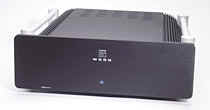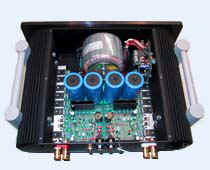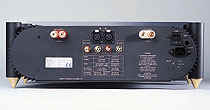You are reading the older HTML site
Positive Feedback
ISSUE
3
simaudio
Moon W-3 amplifier
as reviewed by Bryan Gladstone, Carol Clark, and Dave Clark

(this review ran in the 2001 Issue 13 of audioMUSINGS)
|
BRYAN GLADSTONE'S SYSTEM LOUDSPEAKERS ELECTRONICS SOURCES CABLES
|
 My first
experience with Simaudio was with an integrated amplifier I auditioned while helping a
friend put together a modest system. Despite
the fact that my tastes run strongly towards tubes, I was very impressed with the baby
Sim. My friend and I also auditioned some tubed integrated amps, and he chose a tube amp
rather than the Sim, his solid state amp of choice. Tubes and solid state address
different sonic values, and satisfy different listeners. Which
you choose depends on you. I had had few solid-state
listening hours logged in the year before auditioning the Sim W-3 power amp, and was in
for an eye-opening experience.
My first
experience with Simaudio was with an integrated amplifier I auditioned while helping a
friend put together a modest system. Despite
the fact that my tastes run strongly towards tubes, I was very impressed with the baby
Sim. My friend and I also auditioned some tubed integrated amps, and he chose a tube amp
rather than the Sim, his solid state amp of choice. Tubes and solid state address
different sonic values, and satisfy different listeners. Which
you choose depends on you. I had had few solid-state
listening hours logged in the year before auditioning the Sim W-3 power amp, and was in
for an eye-opening experience.
I don’t feel the need to describe the physical appearance of the W-3, but I do want to mention a few things. First, I love the top rails. They form big handles that make carrying and moving the amp a breeze. This isn’t a big bruiser, but the rails are still handy. Second, the Sim has every input configuration you could ever need. It has the usual RCA inputs for normal operation, XLR inputs for balanced operation, and It has a second set of RCA inputs, wired out of phase. This makes it possible to achieve a balanced input by plugging in two pairs of RCAs, one in phase and one out. I have left my sole peeve for last because it is both the most meaningless and the most annoying. The W-3 has a cobalt blue LED lamp on its faceplate to indicate its run/standby status. This light is BRIGHT!!! If you listen in a darkened room, the LED is like a flashlight shining in your eyes. I’m in the "If it really sounds good, black electrical tape will fix it" camp, but the tape looks terrible. So, does the amp sound good enough to live with tape on the front?
I had forgotten that my ProAcs like power. Do they need it to make their magic? No, but they reveal completely different strengths when they have enough power behind them. >The W-3 seems to deliver power beyond what its modest specs suggest. Suddenly a tubey, mealy-mouthed low end was tightened up. The Sim is like a sports car that doesn’t want to be driven slowly. Driven by the Sim, the ProAcs wanted to play louder, and did so with no effort or strain. The Sim has control that my Rowland Model 1 can’t compete with.
The W-3 doesn’t have the warmth and richness of my Conrad Johnson amp, or even that of the Rowland, though both are a bit warm in color. The W-3 is far more neutral. Neutral amps usually reveal flaws, both in the amplifier and in the associated equipment. The Sim made no such errors. Despite being a bit lean, I found no disturbing fluctuations from flat frequency response. Despite the leanness, the Sim is perfectly balanced. It is also very clean, with no hint of grain or stridency.
The W-3 presents images very precisely. Vocalists have sharply defined lines around their body and an uncanny presence of space between themselves and surrounding instruments. The elements of each recording are very clearly defined and separated. On the other hand, the Sim wasn’t quite as successful as my Conrad Johnson at creating air and space. Also, the Sim does not reproduce the last degree of depth and openness. This should not be a surprise, as it is a tradeoff made in all but the finest amps.
The Sim W-3 is a well-executed example of the type of amp I find in many recoding studio applications. The theory is to impart as little character on the sound as possible. This should be the theory behind all high-end gear, but it isn’t. A warning to those of you that collect old records, listen primarily to old recordings, or have questionable electronics in the chain prior to the Sim. The W-3 is not forgiving, and you will hear every flaw you feed into it, but it won’t add any of its own. If you want to know exactly what your recordings sound like, the W-3 is the sort of amp you are looking for. It is very well built, and deserves to compete within the niche that its price will place it. If you are in the market for an amplifier, as always, weigh the factors and make decisions for yourself, but absolutely put the Sim on your short list. Bryan Gladstone

CAROL CLARK'S SYSTEM: LOUDSPEAKERS ELECTRONICS SOURCES CABLES ACCESSORIES
|
 I am not a
typical forty-two-year-old. I tint my hair purple, I watch professional wrestling on TV
regularly, and I wear jeans to work. By the same token, I am not a typical audiophile. I
use Nine Inch Nails to test equipment! NIN is extremely well recorded. Audiophile-approved
recordings bore me to tears, but I appreciate how they sound, and NIN sounds every bit as
good to me. NIN covers all the lows, highs, and everything in between. It’s not heavy
on the bass, and includes plenty of treble and midrange. As hard as it is for some to
believe, NIN offers a variety of styles as well, everything from the raucously loud to the
peacefully calm. Most of all, I use NIN because I connect with it on an emotional level.
Reviewing equipment can become an almost Zen-like experience, and in order for that to
occur, I have to enjoy the music.
I am not a
typical forty-two-year-old. I tint my hair purple, I watch professional wrestling on TV
regularly, and I wear jeans to work. By the same token, I am not a typical audiophile. I
use Nine Inch Nails to test equipment! NIN is extremely well recorded. Audiophile-approved
recordings bore me to tears, but I appreciate how they sound, and NIN sounds every bit as
good to me. NIN covers all the lows, highs, and everything in between. It’s not heavy
on the bass, and includes plenty of treble and midrange. As hard as it is for some to
believe, NIN offers a variety of styles as well, everything from the raucously loud to the
peacefully calm. Most of all, I use NIN because I connect with it on an emotional level.
Reviewing equipment can become an almost Zen-like experience, and in order for that to
occur, I have to enjoy the music.
We recently had the Simaudio W3 power amp in our system for review. As with all other Sim products, the fit and finish of this unit is outstanding. The controls are easy to use, and have a feeling of solidity. I also found it easy to set up. I usually let Dave do the setup, but I only needed a little gentle guidance from him on this unit, and it was ready to run. This was a definite plus in my book. While putting the W3 through its paces, I listened to a variety of music. Of course, I started with Nine Inch Nails’ latest release, The Fragile.
First up was one of my favorite tracks, "No You Don’t." This song offers a full range of bass, and usually gets my adrenaline flowing for further listening. Directly after "No You Don’t" comes the hauntingly beautiful track, "La Mer," which starts with just acoustic piano and a woman speaking very softly in French. Very atypical of NIN. Another song from this CD that I like to use is the title track. On this track, I can hear Trent Reznor breathing, which usually elicits a response from me. With the W3, I was nearly in tears, it sounded that good. I moved on to another CD I have been listening to quite a lot lately, by the British band the Experiment. What Goes Up is a movie soundtrack. It contains a variety of music, but I tend to listen to the harder-edged tracks. The opening track, "Walk Away," includes samples of people speaking, a chorus singing, and a variety of electronic instruments. Another track that I find interesting is called "This Is What Funk Is For." This is a good track for testing bass responses.
Both sounded as good as they ever do with the W-3. I always rely on Dead Can Dance and Massive Attack when testing equipment. Dead Can Dance’s track "Don’t Fade Away," from Toward The Within, is one that I never tire of hearing. It is simply recorded, with just acoustic guitar and Brendan Perry’s lush vocals. If this track sounds good, I generally like the component I am reviewing. It sounded good with the W-3. The track "Inertia Creeps," from Massive Attack’s release Mezzanine, is another one I usually listen to with new equipment. The W-3 did a stellar job with this track as well. The W-3 sounded great in our system, a trifle less full than the Clayton M70s, but quite pleasing. The soundstage was just as I like it, wider than the speakers, with plenty of depth. The bass was just about right, too. The treble was not harsh or bright. I’ve complained about Sim’s incredibly heavy remote control in the past, and they’ve explained to me that this was to counteract the abuse dished out to remotes. This past January at CES, Lionel Goodfield of Sim showed me their new remote, and I’m happy to report that although it looks like it can hold up to abuse, it is not quite as heavy. I recommend the Simaudio Moon W-3. It is definitely worth a listen. Carol Clark

 The Simaudio W-3 power amp came
into our home with much anticipation. We had the I-5
integrated amp and the P-5003 preamp here for review, and liked both. Were they perfect? Of
course not. As with any product, there were
tradeoffs and compromises, but we felt that both were at the top of their class. The W-3 offers 120 watts @ 8-ohms, which was of interest
to us because our beloved Clayton M70s offer only 70 watts, and we have been wondering
whether moving up to the M100s at 100 watts would offer improvement. While we have tried several low-powered amplifiers that
made music, more power is needed to hear real bass, dynamics, slam, pace, etc.
The Simaudio W-3 power amp came
into our home with much anticipation. We had the I-5
integrated amp and the P-5003 preamp here for review, and liked both. Were they perfect? Of
course not. As with any product, there were
tradeoffs and compromises, but we felt that both were at the top of their class. The W-3 offers 120 watts @ 8-ohms, which was of interest
to us because our beloved Clayton M70s offer only 70 watts, and we have been wondering
whether moving up to the M100s at 100 watts would offer improvement. While we have tried several low-powered amplifiers that
made music, more power is needed to hear real bass, dynamics, slam, pace, etc.
The W-3 raised the bar a bit. More watts did make a difference, allowing the Reimers to go a smidgen lower in the bass, with more growl and slam, which is just what we wanted to hear. Other than this, the comparison between the Sim and the Claytons was a toss-up. Both amps offered a very musical performance without a hint of grain, grit or hardness. The W-3 was fast and clean, neither fat nor bloated, sterile nor lean. The amp possesses much of both the proverbial transistor or tube qualities, and few of their faults It lacks the refinement of the Claytons, and is not as open and transparent, but it will not offend with an overly extended top end or tilted-up midrange.
I do have a few quibbles with the unit’s ergonomics. First, what’s with the on/off switch? It took a good fifteen minutes before I could figure out how to turn the amplifier on. (You press the toggle to "on" and then push in the protruding button.) The unit was also idiosyncratic in how long it stayed on. When idling, it would simnply shut off for no apparent reason. This never happened when music was playing, but seemed to have no reason when or why. It would stay on for several days, then go off, or it would happen several times within a few minutes or hours. The hookup is also kind of lame. The amp is configured so that it can be run mated with another W-3 for mono operation, but when used as a stereo amplifier, the arrangement of the inputs and outputs is not intuitive.
The W-3 made listening to music a joy, and it is a steal. Highly recommended. Dave Clark
W-3 amplifier
Retail $3195
Simaudio
TEL: 877. 980. 2400
web address: www.simaudio.com
